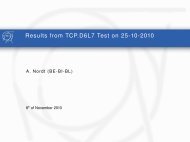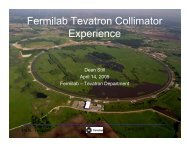Requirements and Design Criteria for the LHC Collimation System
Requirements and Design Criteria for the LHC Collimation System
Requirements and Design Criteria for the LHC Collimation System
You also want an ePaper? Increase the reach of your titles
YUMPU automatically turns print PDFs into web optimized ePapers that Google loves.
5$ (3$&<br />
<strong>Requirements</strong> <strong>and</strong> <strong>Design</strong> <strong>Criteria</strong><br />
<strong>for</strong> <strong>the</strong> <strong>LHC</strong> <strong>Collimation</strong> <strong>System</strong><br />
R. Assmann, CERN-SL<br />
<strong>for</strong> <strong>the</strong> <strong>LHC</strong> Beam Cleaning Study Group:<br />
R. Assmann, M. Brugger, H. Burkhardt, G. Burtin, B. Dehning,<br />
C. Fischer, B. Goddard, E. Gschwendtner, M. Hayes,<br />
J.-B. Jeanneret, R. Jung, V. Kain, M. Lamont, R. Schmidt,<br />
E. Vossenberg, E. Weisse, J. Wenninger, CERN, Geneva;<br />
I. Baishev, IHEP, Protvino, Moscow Region;<br />
D. Kaltchev, TRIUMF/University of Victoria, Victoria<br />
…including colleagues from connected activities (beam dump).<br />
Work started in September 2001.
5$ (3$&<br />
Contents<br />
1) The challenge<br />
High stored energy <strong>and</strong> energy density<br />
Super-conducting environment<br />
Efficient <strong>and</strong> tight collimation<br />
2) Irregular proton losses<br />
Dump failure modes<br />
Beam impact at collimators<br />
3) Regular proton losses<br />
Running at <strong>the</strong> quench limit (intensity <strong>and</strong> beam lifetime)<br />
Heat load<br />
Efficiency <strong>and</strong> imperfections (halos)<br />
4) Outlook
5$ (3$&<br />
What is collimation <strong>for</strong> <strong>the</strong> <strong>LHC</strong>?<br />
Blocks of material that are put closest to <strong>the</strong> beam such that:<br />
99.9 % of protons lost (e.g. with 1 h beam lifetime at 7 TeV) are captured in<br />
<strong>the</strong> collimators.<br />
Less than 0.1 % of protons lost can escape <strong>and</strong> can impact in <strong>the</strong> SC<br />
magnets, which o<strong>the</strong>rwise quench.<br />
Less than 0.002 % of <strong>the</strong> stored beam intensity can be lost at any place in<br />
<strong>the</strong> ring o<strong>the</strong>r than <strong>the</strong> collimators, because o<strong>the</strong>rwise magnets could be<br />
damaged.<br />
Any beam loss is detected immediately at <strong>the</strong> collimators <strong>and</strong> <strong>the</strong> beam is<br />
dumped within 2-3 turns.<br />
(top energy)
Number of bunches: 2808<br />
Bunch population: 1.1e11<br />
Bunch spacing: 25 ns<br />
Top energy:<br />
5$ (3$&<br />
Challenge: High Stored Energy 1<br />
Proton energy: 7 TeV<br />
Transv. beam size: 0.2 mm<br />
Bunch length: 8.4 cm<br />
Stored beam energy: 350 MJ<br />
Injection:<br />
Proton energy: 450 GeV<br />
Transv. Beam size: 1 mm<br />
Bunch length: 18.6 cm<br />
Physics Potential =<br />
Energy <strong>and</strong> Luminosity:<br />
Factor 1000 in transverse energy density!<br />
Increase transverse energy density<br />
d = demagnification<br />
N p = protons per bunch<br />
f rev = revolution freq.<br />
E b = beam energy
5$ (3$&<br />
Challenge: High Stored Energy 2<br />
If you are interested in material damage:<br />
Energy density (3 <strong>LHC</strong> bunches) = Energy density (full HERA-p beam)<br />
If your are interested in heat load:<br />
Energy (20 <strong>LHC</strong> bunches) = Energy (full HERA-p beam)<br />
If you are interested in real things:<br />
= Energy to melt 3 kg Copper<br />
Energy (2 full <strong>LHC</strong> beams) = 7% of energy stored in an airplane<br />
carrier at 30 knots<br />
K.H. Mess<br />
Picture of damaged SLC collimator
Destruction limits<br />
Case<br />
Copper<br />
Beam screen<br />
S.C. coil<br />
5$ (3$&<br />
Challenge: High Stored Energy 3<br />
5-12 nominal<br />
bunches at<br />
injection<br />
Destruction threshold<br />
[nominal intensity]<br />
1.9e-3<br />
1.6e-3<br />
4.2e-3<br />
1.8e-5<br />
7.0e-5<br />
14.0e-5<br />
0.05-0.4 nominal<br />
bunches at<br />
top energy<br />
This made <strong>the</strong><br />
reconsideration of<br />
present collimator<br />
jaw materials<br />
necessary!<br />
No safe<br />
operating<br />
point <strong>for</strong><br />
<strong>LHC</strong> (top)<br />
without<br />
protection!
5$ (3$&<br />
Challenge: Super-Conducting Super Conducting Environment<br />
Proton losses into cold aperture<br />
Energy<br />
[GeV]<br />
450<br />
7000<br />
Local heat deposition<br />
Magnet can quench<br />
Loss rate<br />
(10 h lifetime)<br />
8.4e9 p/s<br />
8.4e9 p/s<br />
Quench limit<br />
[p/s/m]<br />
(steady losses)<br />
7.0e8 p/s/m<br />
7.6e6 p/s/m<br />
Illustration of <strong>LHC</strong> dipole in tunnel<br />
Cleaning<br />
requirement<br />
92.6 %<br />
99.91 %<br />
Control transient<br />
losses (10 turns)<br />
to ~1e-9 of<br />
nominal intensity<br />
(top)!<br />
Capture (clean) lost protons be<strong>for</strong>e <strong>the</strong>y reach cold aperture!<br />
Required efficiency: ~ 99.9 % (assuming losses distribute over 50 m)
5$ (3$&<br />
Challenge: Tight <strong>and</strong> Efficient <strong>Collimation</strong> 1<br />
Collimator settings:<br />
5 - 6 V (primary)<br />
6 - 9 V (secondary)<br />
V ~ 1 mm (injection)<br />
V ~ 0.2 mm (top)<br />
Number of protons<br />
reaching 10V:<br />
10 -4 of p at 6 V<br />
Reminder: Normalized available <strong>LHC</strong> aperture specified to be<br />
10V at injection (arcs) <strong>and</strong> top energy (triplets).<br />
+ 3-4 mm <strong>for</strong> closed orbit, 4 mm <strong>for</strong> momentum offset, 1-2 mm <strong>for</strong> mechanical tolerances
5$ (3$&<br />
Challenge: Tight <strong>and</strong> Efficient <strong>Collimation</strong> 2<br />
Two <strong>LHC</strong> insertions<br />
dedicated to cleaning:<br />
IR3 Momentum cleaning<br />
1 primary<br />
4 secondary<br />
IR7 Betatron cleaning<br />
4 primary<br />
16 secondary<br />
Two-stage collimation system.<br />
50 movable collimators <strong>for</strong> high efficiency cleaning<br />
+ o<strong>the</strong>r absorbers <strong>for</strong> high amplitude protection
5$ (3$&<br />
Contents<br />
1) The challenge<br />
High stored energy <strong>and</strong> energy density<br />
Super-conducting environment<br />
Efficient <strong>and</strong> tight collimation<br />
2) Irregular proton losses<br />
Dump failure modes<br />
Beam impact at collimators<br />
3) Regular proton losses<br />
Running at <strong>the</strong> quench limit (intensity <strong>and</strong> beam lifetime)<br />
Heat load<br />
Efficiency <strong>and</strong> imperfections (halos)<br />
4) Outlook
Equipment failures<br />
Equipment errors<br />
Operational errors<br />
5$ (3$&<br />
Irregular proton losses<br />
Danger of damage to accelerator<br />
components.<br />
In particular: Collimators<br />
close to beam!<br />
Beam dump: <strong>Design</strong>ed to extract beam within 2 turns.<br />
Pulse rise time of 3 µs (dump gap).<br />
Failure modes:<br />
- Total failure of dump or dump trigger (> 100 years)<br />
- Dump action non-synchronous with dump gap<br />
- Dump action from 1 of 15 modules, o<strong>the</strong>rs<br />
retriggering after 1.3 µs.<br />
Magnet failures: V. Kain et al, MOPLE032<br />
Difficult to predict<br />
Assume at least<br />
once per year!
5$ (3$&<br />
Abnormal dump actions<br />
Kick [µrad] Downstream offset [σ]<br />
One module pre-fire
5$ (3$&<br />
Abnormal dump actions<br />
Beam abort asynchronous<br />
with abort gap:<br />
Total: 6 bunches over 5 σ<br />
Peak: 1.5 bunches in 1 V<br />
1 module pre-fire with retriggering<br />
of 14 after 1.3µs:<br />
Total: 20 bunches over 5 σ<br />
Peak: 6 bunches in 1 V
5$ (3$&<br />
20 bunches<br />
Abnormal dump actions<br />
One module pre-fire<br />
depends on details of dump<br />
kicker design (pulse <strong>for</strong>m,<br />
number of magnets, re-trigger<br />
design)!<br />
Possible remedies are being<br />
studied (require modifications<br />
to dump system).<br />
Collimators should withst<strong>and</strong> this impact without damage!<br />
Consequences <strong>for</strong> choice of material, jaw length, operation, exchange<br />
facilities, setting of TCDQ (10σ), distribution of radioactivity, …<br />
Low Z collimator material!
5$ (3$&<br />
Contents<br />
1) The challenge<br />
High stored energy <strong>and</strong> energy density<br />
Super-conducting environment<br />
Efficient <strong>and</strong> tight collimation<br />
2) Irregular proton losses<br />
Dump failure modes<br />
Beam impact at collimators<br />
3) Regular proton losses<br />
Running at <strong>the</strong> quench limit (intensity <strong>and</strong> beam lifetime)<br />
Heat load<br />
Efficiency <strong>and</strong> imperfections (halos)<br />
4) Outlook
5$ (3$&<br />
Regular proton losses<br />
Proton losses observed in routine operation (include operational variation<br />
of beam lifetime)! Studies <strong>for</strong> system with Al/Cu jaws.<br />
Desirable:<br />
1) Possibility to run at quench limit (τ = 0.2 h <strong>for</strong> top energy)<br />
2) Accept low lifetimes during cycle<br />
Additional<br />
requirements <strong>for</strong><br />
collimator hardware!
5$ (3$&<br />
Two stage collimation system<br />
Adapted from J.B. Jeanneret<br />
Betatron cleaning: 4 primary <strong>and</strong> 16 secondary collimators<br />
Optimize phase advance <strong>for</strong> minimal secondary halo
5$ (3$&<br />
Improving our confidence in predictions<br />
Two scattering routines used: K2 <strong>and</strong> STRUCT<br />
Tracking programs: Linear transfer matrices<br />
DIMAD<br />
SIXTRACK<br />
Effects being considered: Scattering physics<br />
Chromatic effects<br />
Non-linear fields (diffusion)<br />
preliminary<br />
M. Hayes et al, WEPLE044<br />
F. Zimmermann et al, WEPLE048<br />
R. Assmann et al, MOPLE030<br />
Same order of magnitude results<br />
Factor 5 disagreement to be<br />
understood.<br />
<strong>System</strong> requires detailed underst<strong>and</strong>ing<br />
of 7 TeV proton interaction in matter.
5$ (3$&<br />
Secondary <strong>and</strong> tertiary beam halos<br />
Scattering in collimator<br />
jaws (at 6/7 σ)<br />
Transverse scattering angles<br />
+ momentum loss<br />
Halo at zero dispersion<br />
Halo at max dispersion<br />
Local inefficiency [1/m]:<br />
Integrate halos above 10σ<br />
Divide by dilution length (50 m)
5$ (3$&<br />
Tertiary halo in phase space<br />
Halo generated<br />
at specific<br />
phase space<br />
locations!<br />
Input to studies of local loss distribution (dilution,<br />
expected signals of Beam Loss Monitors BLM).<br />
E. Gschwendtner et al, THPRI083
5$ (3$&<br />
Running at <strong>the</strong> quench limit <strong>for</strong> W = 0.2 h<br />
Trade-off <strong>for</strong> given quench limit between:<br />
Inefficiency – Allowed intensity – Minimum allowable lifetime
5$ (3$&<br />
Inefficiency with imperfections<br />
Value of imperfections <strong>for</strong> 50% increase (each) in inefficiency:<br />
Transient<br />
changes<br />
Collimators need not only be<br />
robust, but also precise!<br />
Beam<br />
R. Assmann et al, MOPLE030<br />
Preliminary<br />
estimates:<br />
Combined effect can<br />
make tolerances<br />
more severe!<br />
5 V mm
5$ (3$&<br />
Summary <strong>and</strong> Outlook 1<br />
Beam impact requirements analyzed (failure modes <strong>and</strong> operational<br />
requirements) <strong>for</strong> a robust <strong>and</strong> efficient <strong>LHC</strong> collimation system!<br />
Now engineering design starting: appropriate materials (low Z), lengths,<br />
mechanics, cooling, damage <strong>and</strong> fatigue analysis, tolerances, …<br />
Additional concerns: Impedance, vacuum, local e-cloud, radiation impact.<br />
Two cleaning insertions, each two-stage, defined since years <strong>for</strong> high<br />
efficiency cleaning.<br />
Accelerator physics <strong>and</strong> operational analysis is ongoing:<br />
Overall tolerance specifications (flatness, required adjustments, orbit <strong>and</strong> optics<br />
requirements, …). Operational optimization. Realistic diffusion <strong>and</strong> aperture<br />
models (BLM signals). Chromatic effects.<br />
Cross-checks of different scattering <strong>and</strong> tracking tools.
The per<strong>for</strong>mance of <strong>the</strong> collimation system can limit…<br />
5$ (3$&<br />
Summary <strong>and</strong> Outlook 2<br />
… peak luminosity due to maximum allowed intensity.<br />
… integrated luminosity due to beam aborts <strong>and</strong> repair time.<br />
This we want to prevent with <strong>the</strong> best possible design!<br />
<strong>Collimation</strong> is a per<strong>for</strong>mance-critical topic<br />
from day 1 of <strong>LHC</strong> physics!<br />
It pushes accelerator physics underst<strong>and</strong>ing of beam halo <strong>and</strong> material<br />
science to new frontiers!
5$ (3$&<br />
Additional slides
5$ (3$&<br />
Inefficiency versus settings
5$ (3$&<br />
Inefficiency versus imperfections<br />
Beta beat Non collinearity<br />
Orbit<br />
Jaw length
Scattering<br />
physics<br />
5$ (3$&
5$ (3$&<br />
Multi-turn properties <strong>and</strong> impact parameter<br />
Primary impact parameter<br />
Survival after impact<br />
Survival half time<br />
Proton number vs turn


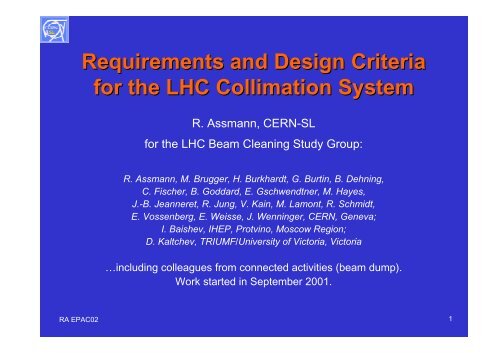
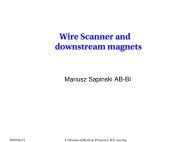

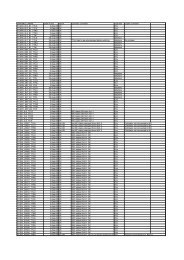
![marek.ppt [Read-Only] - LHC Collimation Working Group - Cern](https://img.yumpu.com/18209900/1/190x135/marekppt-read-only-lhc-collimation-working-group-cern.jpg?quality=85)
